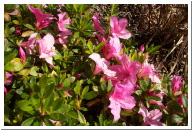
Today was garden cleanup day here at AGN headquarters. We called in our favorite tree maintenance service to trim about 8 trees throughout the garden. I have posted a few photos of our work today so you can see what is happening around here.
All the dead limbs were pulled out of our weeping willow, which is just starting to leaf out for the season. It looks a bit ragged right now, but I think it will be much healthier this year. We noted some signs of insect damage on the dead sections, so hopefully this will help the tree heal itself.
The workers also thinned a pine tree in our front yard. This was originally a live Christmas tree planted by the former owners. It has suffered quite a bit over the years, having been "topped" at least a couple of times. It also looks a bit thing now, but it is starting to regain its natural shape and should look even better by next year.
The azaleas in the front yard have been blooming for about a week and are looking quite lovely. They are all shaggy right now and will need their own haircut after the bloom has finished.
Finally, Joe and I planted the "Shady Mix" of native wildflower seeds in the back garden once the workmen had finished. We should start to see sprouts in about 1-1/2 - 2 weeks.
We also finished a job I had been meaning to do for months. We have several humps of Society Garlic (Tulbaghia violacea) spread throughout the garden. I have been slowly gathering all these plants, dividing them, and planting them along the edge of a long curving path through the "woodland" part of the garden.
The plant divides very easily, being a loose collection of individual bulbs or corms. I am not quite sure which. I only have to shake the clump in my hand, or maybe tease it apart gently with my finders. There are plenty of large and small roots on every plant, So I think it should be a successful transplant. My previous move had a nearly 100% success rate. That certainly doesn't happen every day!
Today's work also marks the start of preparations for our big, annual Garden Party. Each June, around the time of our wedding anniversary, we invite all our friends over to enjoy a big potluck meal and sit around playing music or just chatting. The kids have a blast and the parents can easily keep an eye on them while relaxing for a few hours. There is still more garden work to do before then, but I feel much better getting so much out of the way in one day.



